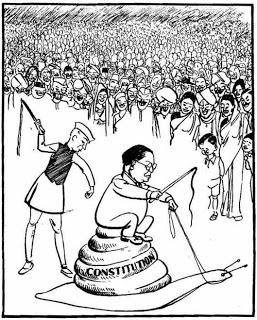
Cartoonist’s impression of the snail’s pace
with which the constitution was made.
Even a cursory reading of the textbook would suggest that there is nothing in the textbook that even remotely insults Ambedkar. The textbook, rather, is an excellent guide to the uninitiated on the history of Indian constitution, its influence in shaping our institutions and the “politics of power surrounding them”. It is a shame to find the politics of identity encroaching academic space, and being hell bent on bestowing intolerance and bigotry upon the future social and political scientists of this country. The political class, as we watch, is outperforming itself, everyday, by plummeting to new depths of absurdity.Politics of IdentityThe state is unashamed to destroy our fundamental freedoms to satiate the demands of lunatic elements. To understand how the political class threatens to destroy our fundamental rights, it is necessary to view these events of bans in the context of how politics in India mobilizes people and how such a mobilization grants legitimacy to acts of transgressions by the state. It is no secret that the political class in India has, over the years, mobilized support by constructing identities, built on foundations of various entities like caste, religion, language, region, historical figures, etc. Identities do provide a sense of social purpose- in mitigating crisis and creating opportunities for individuals to progress as a collective. It is this nature of identity-to foreswear self at the altar of the collective- that has provided the requisite fodder for the politics of identity to grow fat, mobilize support and bully the society to act as directed. If the politics of identity has enabled the social mobility of several marginalized groups, it has equally been responsible for sharpening the fault lines between different groups. This has led to the creation of islands of allegiances, each with its own claims, in a sea of bitter hostility and mutual suspicion. The unspoken convention, therefore, is to render these identities sacred, so as to maintain a semblance of peaceful coexistence. This facilitates the political class, to whip up frenzy at will and manufacture controversy even out of frivolous issues, and thus muzzle even ‘impartial spectators’ who question their dubious claims. Anatomy of bans As recent events suggest, the political class is more than willing to stifle free expression under the dubious garb of protecting communal harmony and respecting popular sentiment. It is time someone called this bluff and exposed it for what it is-a sham. The anatomy of banning certain expressions of art by the state is simple. The ingredients necessary for the outcome – a sense of identity around a large social base and political accreditation of the same- are accumulated over a period of time. The actual production of the ban happens in three stages. First, the custodians of a particular identity constantly pry to look for corners to be insulted. ‘Insult’ to their identity is invoked over an array of things like differing opinions, alternate standpoints, works of fiction, etc. Second, the perceived insult mutates into offense- “How dare that bloody cartoonist exaggerate the facial features of my leader based on his whims?”. 'Offense', as we have come to know, is a powerful tool in the semantic armory of agents espousing politics of identity. Third, the perceived offense is used as an excuse to mobilize outrage and vandalize public property. The final step to muzzle free expression is then set in motion under the pretext of protecting law and order, and maintaining communal harmony. The state, thus, successfully evades from its primary responsibility of protecting individual rights by ceding space to vandals, first by enabling them to destroy public property and then using that as a pretext to curtail free expression. Sanctifying individuals A part of this entire problem lies in our tendency to consecrate abstract entities, our obsessive affinity towards symbols, and deification of individuals- forever elevating them to a stature inaccessible for its adherents to reach. This misplaced agenda of viewing individuals and ideas as mere symbols and material objects to protect, without understanding what they or their ideas stood for, has stagnated our public discourse, perennially, on issues that really matter. Another aspect of deification of historical figures (or any individual for that matter) is that it reduces the individual to a single constituent. This would entail that the adherents- who sanctified the individual in the first place- have to justify every single claim of the individual they purport to worship, and thereby showing complete disregard for honest intellectual probing into the validity of his claims over a plurality of issues. Understood in this context, it is imperative for public opinion to be mobilized on individual issues, each with their sound bearings to reason and critical scrutiny. To paraphrase Pratap Bhanu Mehta- “The problem in India seems to be that everybody wants to do someone else’s job”. Police wants to be moral police; Vandal's want to be artists; Judge's policy maker's; Cricketer’s legislator's; Legislator's academician's. Nobody wants to mind their own fucking business. Therein lays our problem.
